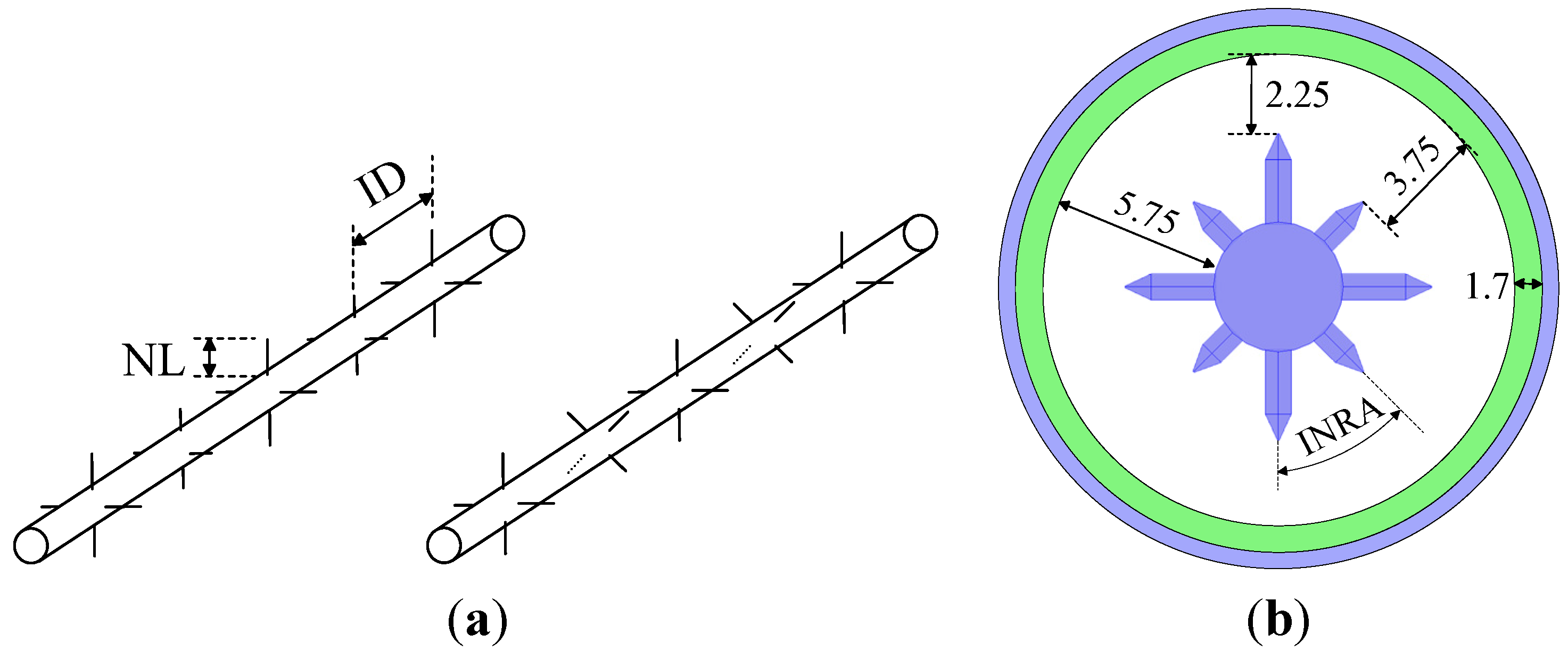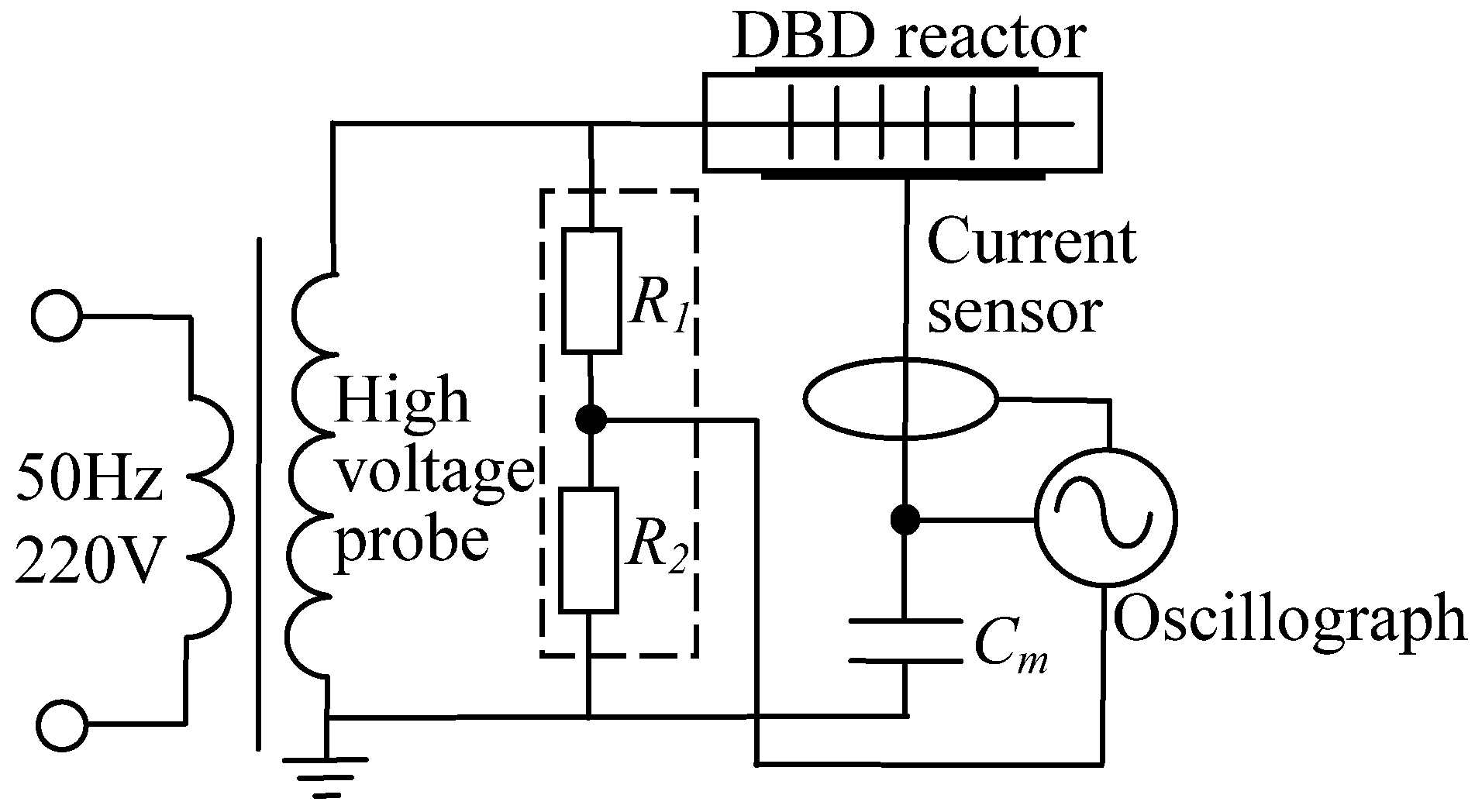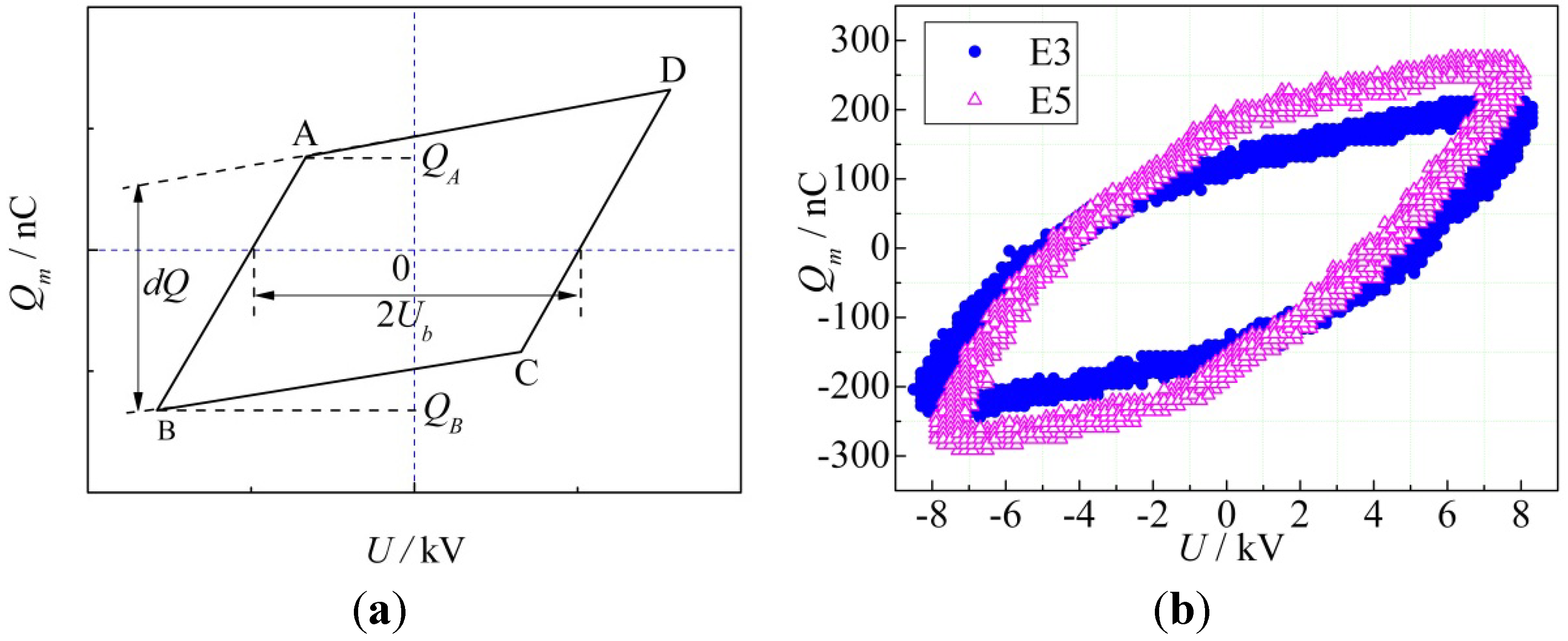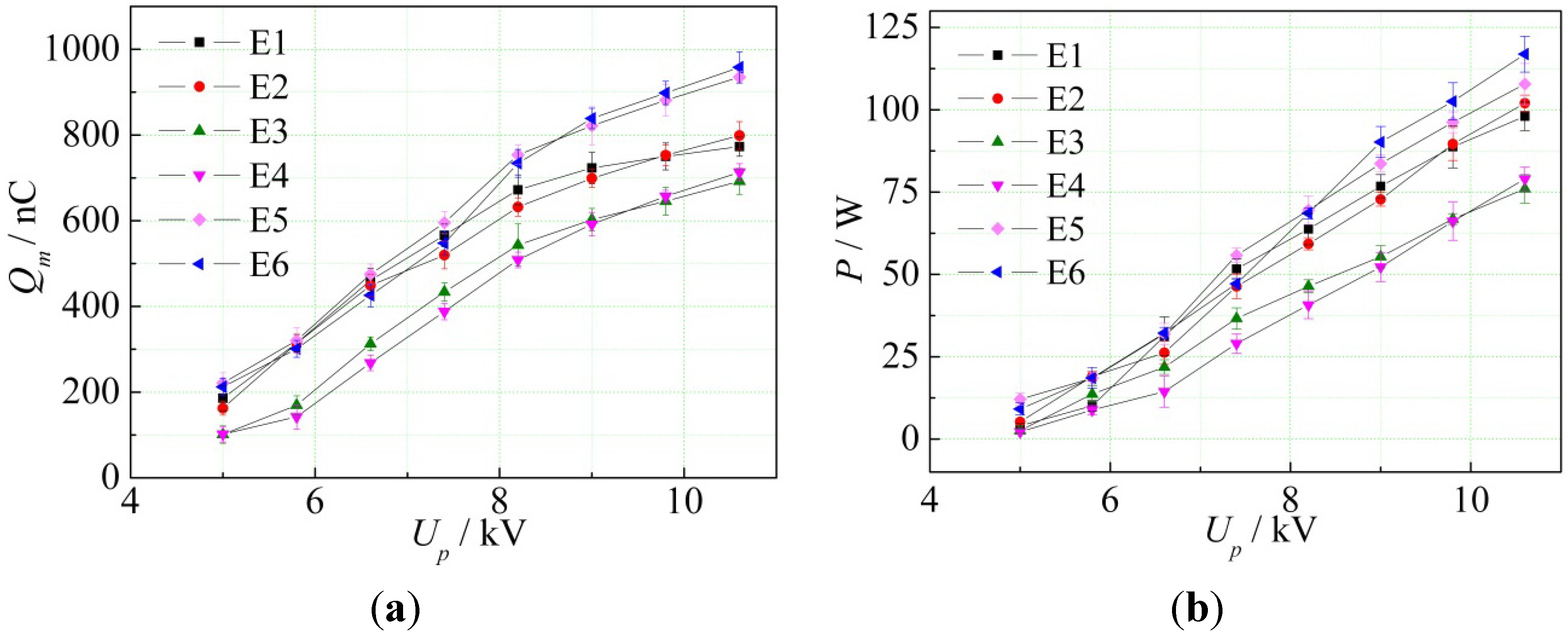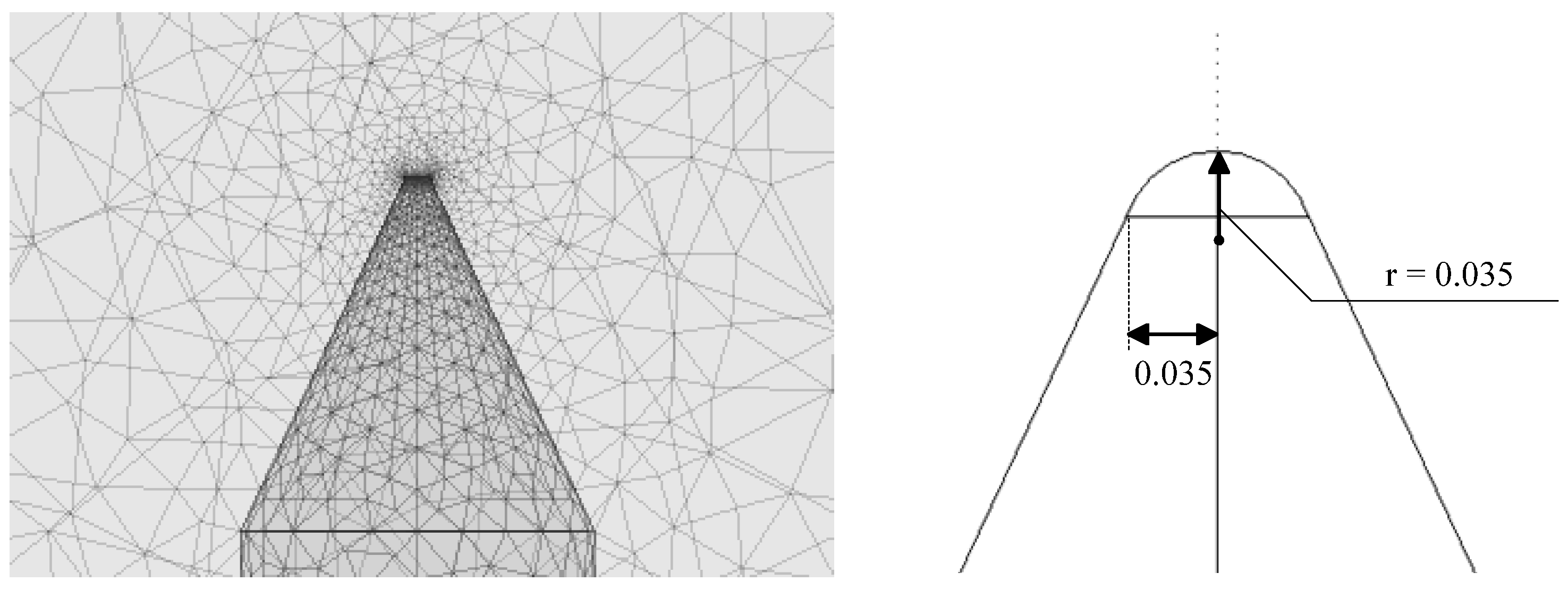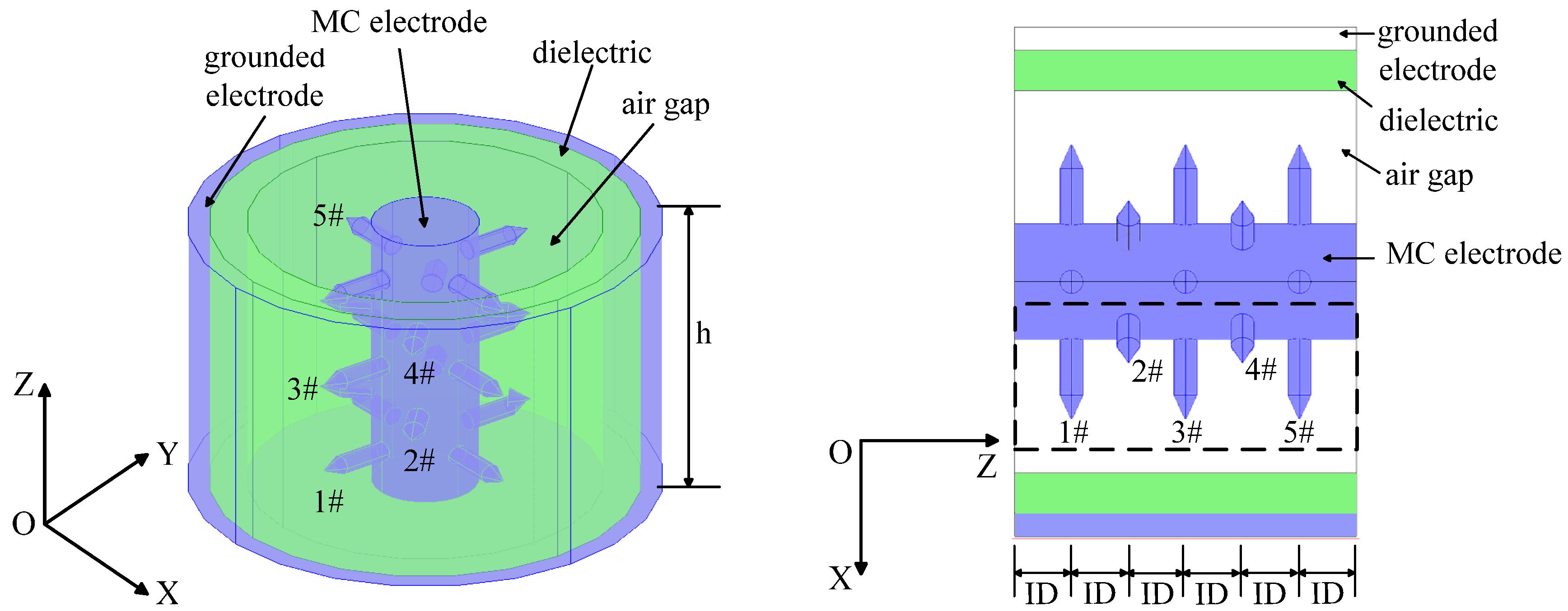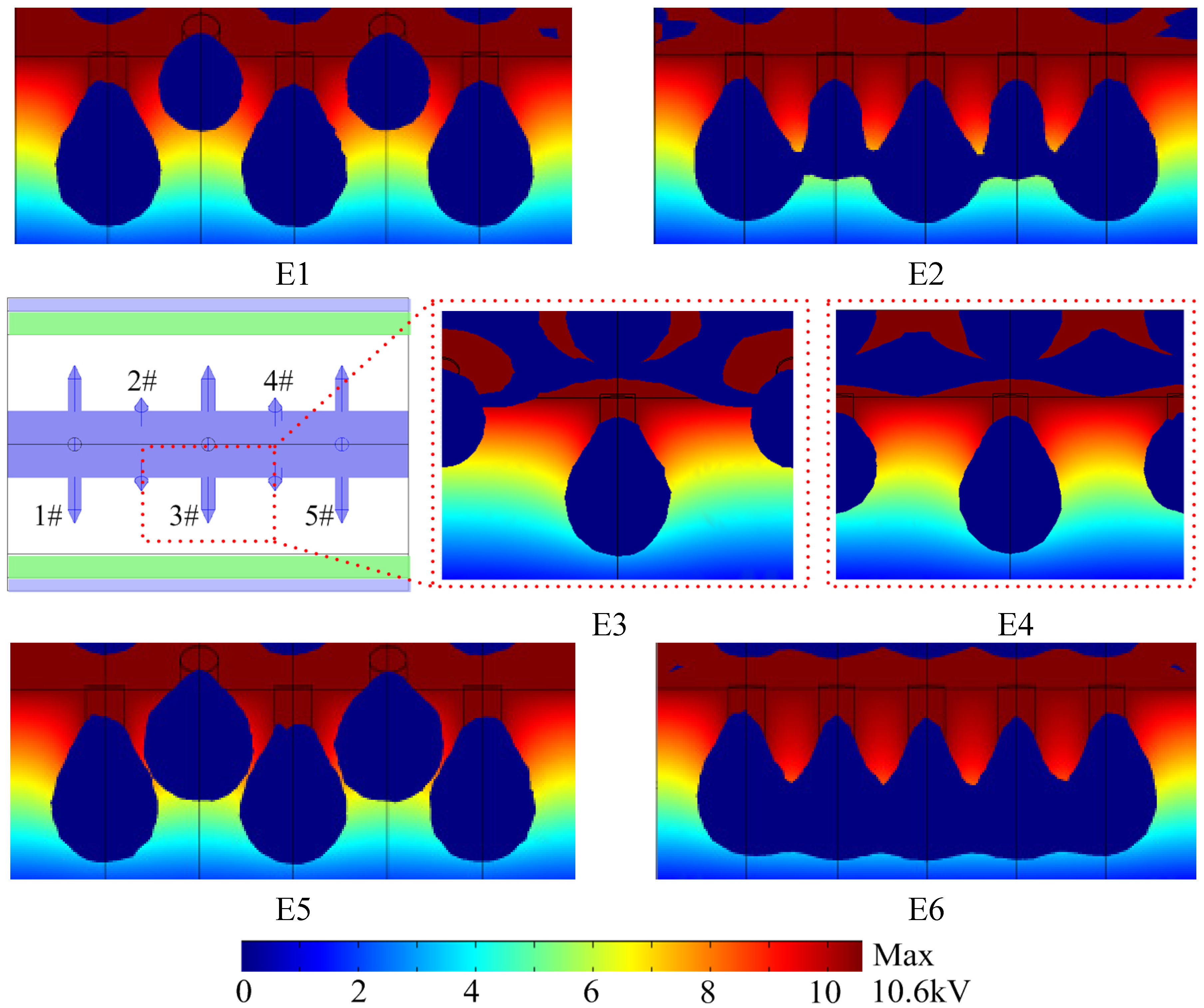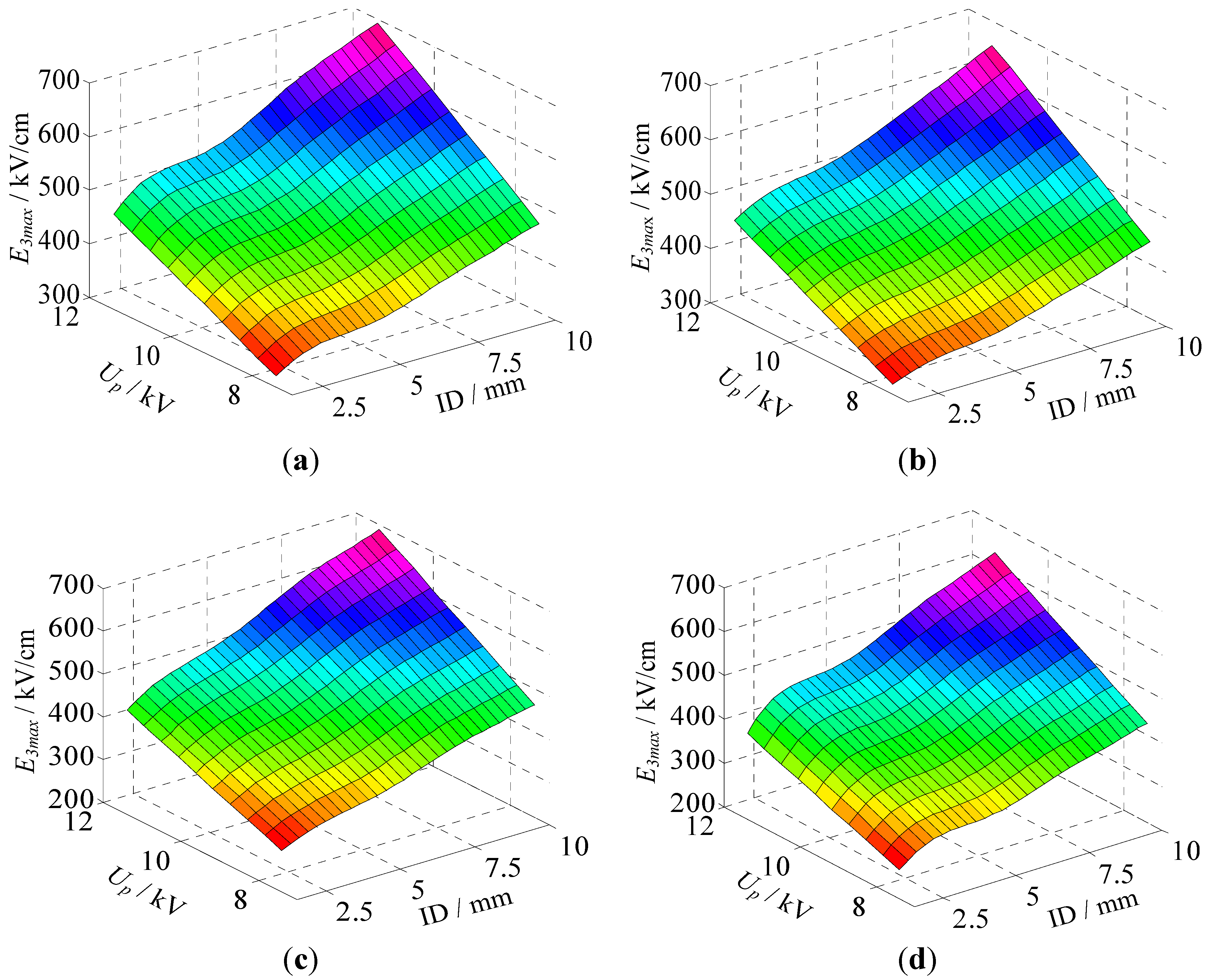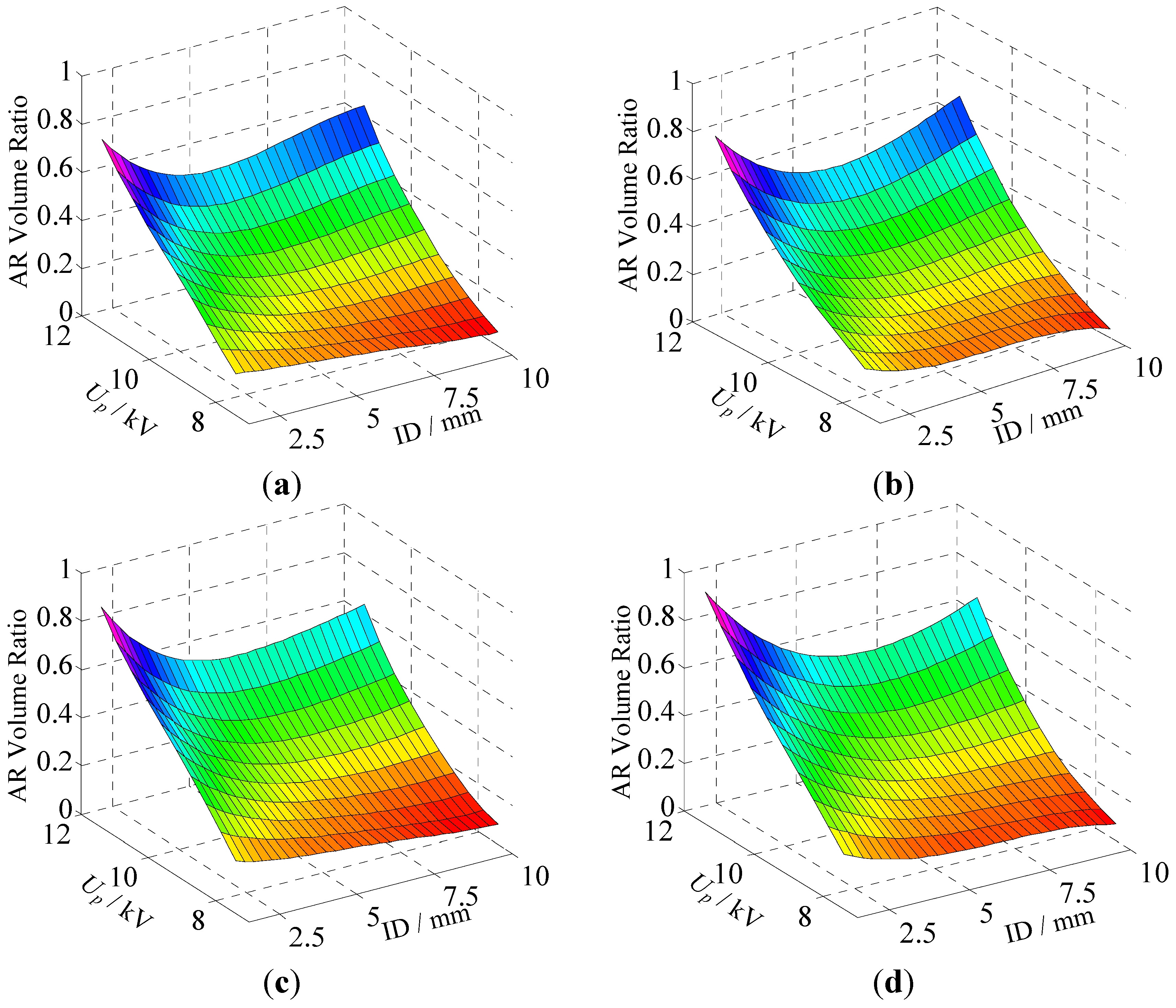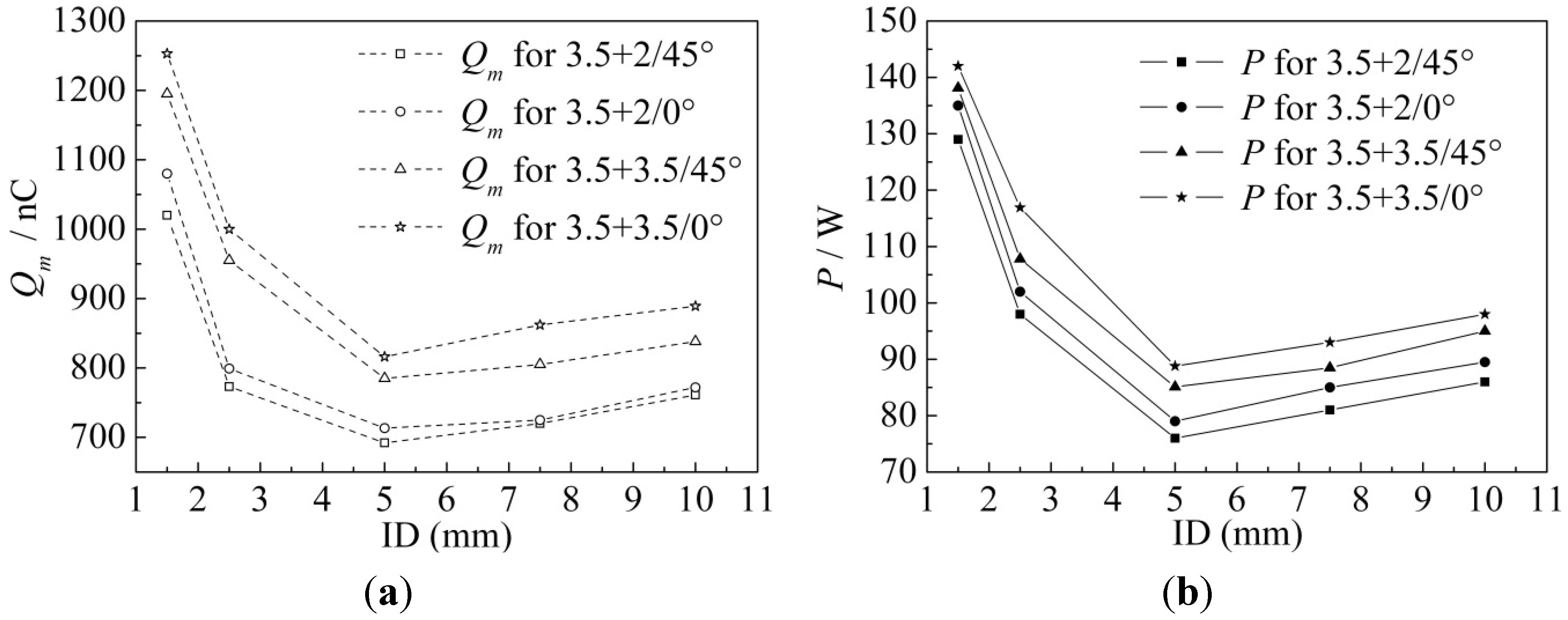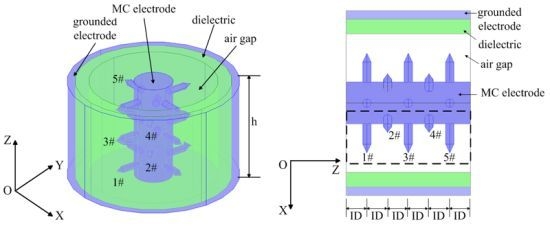1. Introduction
The use of non-thermal plasma (NTP) produced through gas discharge has become an active area of research. Dielectric barrier discharges (DBDs) have a number of industrial applications, such as surface modification, environmental protection, medicine, and plasma displays, because they can produce large volume and high-energy-density NTPs at atmospheric pressure over a wide range of frequencies without expensive vacuum equipment [
1,
2,
3,
4,
5].
Power supply and reactor type have a major effect on DBD characteristics. A reactor can be classified using electrode configuration, electrode materials, barrier dielectric materials, and the presence of a catalyst between electrodes [
6,
7,
8,
9,
10,
11,
12,
13,
14]. These configurations and materials each have advantages and disadvantages for different practical applications. For DBD electrodes, plane-to-plane or coaxial structures are generally adopted [
2]. Improvements for plane-to-plane structures to increase energy input efficiency have been proposed, such as multineedle-to-plane (MP) [
6,
7,
8,
9,
10], mesh-to-plate [
3], and trench-to-plane [
11] configurations. These configurations are proven better for some applications because they could generate a non-uniform electric field in space, resulting in low operating voltage and low dielectric loss, which are beneficial for commercial use.
Few improvements concerning coaxial structures have been proposed. In our previous study, the MC configuration,
i.e., needles arrayed on the inner axial electrode, was proposed [
13,
14]. Our previous study showed that the introduction of needles resulted in a further distorted electric field of the MC reactor, that was initially uneven between the coaxial electrodes, both at 50 Hz and at higher frequencies (17–29 kHz) [
13,
14]. The MC configuration reduced the initial discharge voltage and operation voltage and improved transported charges compared with the coaxial configuration. Meanwhile, research also showed that a smaller ID resulted in a greater amount of transported charges [
13,
14]. However, the results may only be valid for a limited number of cases because the previous experiments were designed within a limited parameter range.
In recent years, computer modeling has and will continue to benefit the investigation of DBD plasmas, particularly in areas such as plasma reactor optimization [
15]. To investigate the DBD plasmas and the use of DBD plasmas in technological devices, three basic models are usually employed: fluid-hydrodynamic model, particle-in-cell/Monte Carlo collision (PIC/MCC) model and hybrid models [
5,
15,
16,
17,
18,
19,
20,
21,
22]. Fluid models have been developed both for low and high pressure discharges. Natalia
et al. reported a multi-fluid hydrodynamics simulation to investigate the ion energy and angular distributions incident on dielectric flat surfaces resulting from the intersection of DBD filaments sustained in atmospheric pressure air [
16]. PIC/MCC method provides the most detailed information on the properties (e.g., velocity distributions) of the electrons, ions and atoms [
19,
20]. Hybrid models have been developed to do practical simulations without losing non-equilibrium properties such as ionization and dissociation rates. Kushner [
22] proposed a hybrid model to address different physical processes or address the same physical processes using different techniques. The hybrid model in [
15] combined computational modules, including sheath module, magnetostatic module, electromagnetics module, electron energy transport module, fluid kinetics-poisson module, surface kinetics module, dust transport module, radiation transport Monte Carlo module, plasma chemistry Monte Carlo module, real time control module, sputter module, ion Monte Carlo simulation and circuit module, which transfer information between them in a hierarchical manner, thus the algorithms best suited for the conditions of interest can be used without affecting other modules. Impressive advances have been made in the development of these models and they have been widely employed in both the investigation of fundamental physics and for the design of plasma equipment, although the amount of calculation required for these models is so enormous that multi-core processors and parallel computers are needed.
Therefore, in the current paper computational modeling in the quasi-static field is adopted to optimize the discharge formation of MC configurations in atmospheric air. The model is obviously easier and time saving compared with the above three models, which is proven by the experiments adopted in this paper.
The DBD which occurs at atmospheric pressure usually consists of a multitude of current filaments of short duration [
2,
23,
24]. In the life cycle of one such filament three separate steps can be discerned: (1) The formation of the discharge,
i.e., the electrical breakdown; (2) the ensuing current pulse or transport of charge across the gap; and (3) simultaneously the excitation of the atoms and molecules ocurrs and thus initiation of the reaction kinetics. As it is known, avalanches are generated in the region in which electric field
E > 26 kV/cm in atmospheric air [
24]. Rong
et al. [
9] used an electrostatic model to optimize interneedle-distance of a multineedle-to-plane barrier discharge reactor through analyzing the patterns of such regions, which were termed the active region (AR), and AR volume ratio was termed the volume of AR over the entire air volume between the electrodes in [
9]. However, the electric field distribution in the discharge space is neither a steady current field, nor a static field in the complete sense. Hence, accurate results cannot be obtained either by the steady-current-field-solving method nor by the static-field-solving method [
25,
26]. In the present work, the three-dimensional (3-D) finite element method (FEM) and quasi-static field simulation are used to optimize the discharge formation of MC configurations in atmospheric air, in which AR and AR volume ratio defined in [
9] are introduced in the present work.
During simulation in the current paper, the mutual effects of nearby needles and that between needles and an inner axial electrode are found to influence DBD properties, including AR patterns, the AR volume ratio and the electric field strength.
In simulation, shorter ID (1.5 mm) and needles with similar lengths (3.5 mm) were arranged, resulting in a greater AR volume ratio for the same applied voltage. In this case, the AR volume ratio generated by the configuration with an INRA of 45° is greater than that generated at 0° when the voltage exceeds 8.2 kV. Therefore, in the current paper this configuration (3.5 + 3.5/45°/1.5) is the optimal structure, wherein the maximum AR volume ratio can be obtained using a specific operating voltage greater than 8.2 kV.
The simulation results are experimentally confirmed through transported charges per cycle and discharge power obtained through Lissajous figures. Quasistatic field simulation is validated to be a reliable and convenient method to analyze DBD characteristics for an MC configuration.
5. Simulation Results and Discussion
Energized electrons play a dominant role in practical DBD applications; therefore, the regions in which electron avalanches are generated are worth investigating. Avalanches are generated in the region wherein the electric field is
E > 26 kV/cm at atmospheric pressure [
24].
An increase of the electric field strength in the air gap of the reactor may lead to an increase in discharge intensity and an increase of microdischarge channels in the discharge space, thus may result in more transported charges in the space. Furthermore, the AR volume ratio is a positive function of discharge power density. Therefore, an increase in the AR volume ratio may result in higher energy input efficiency.
For practical DBD application, obtaining the highest energy input efficiency via the lowest possible operating voltage is ideal because the power supply cost is lowest. To determine the energy input efficiency of the reactors, the AR volume ratios have been investigated in the current work (shown in
Figure 7). A series of operating voltages ranging from 5 to 12.2 kV with a resolution of 0.8 kV is investigated.
Figure 7.
The AR volume ratios obtained from COMSOL as a function of operating voltage for E1–E6.
Figure 7.
The AR volume ratios obtained from COMSOL as a function of operating voltage for E1–E6.
The AR volume ratios of the electrodes with NL = 3.5 + 3.5 mm are greater than those of NL = 3.5 + 2 mm, and the AR volume ratios of the electrodes with ID = 2.5 mm are also greater than those of ID = 5 mm. For the electrodes with ID = 2.5 mm, the AR volume ratios of configurations with INRA = 45° are greater than those at INRA = 0° when the applied voltage is relatively low, but the phenomenon is significantly different when the applied voltage exceeds a specific value, similar to the variation tendency of Qm–Up and P–Up. For example, the AR volume ratio of E2 exceeds that of E1 when the applied voltage is greater than approximately 10.3 kV, and E6 exceeds E5 when Up is greater than approximately 8.5 kV.
It can be concluded that E5 and E6 are preferred structures, because an increase in the AR volume ratio may result in more transported charges, higher discharge power density and higher energy input efficiency. This is also in accordance with the experimental result. The results of the simulation and experiments (
Figure 4 and
Figure 7) are similar in that they are mutually authenticated.
Differences between the experimental results (
Figure 4) and the simulation (
Figure 7) are observed, although the variation tendencies are similar: (1) the AR volume ratio of E3 and E4 are almost identical, whereas the
Qm and the
P of E3 and E4 are different; (2) the applied voltages corresponding to the
Qm and
P of INRA = 0° exceeds those of INRA = 45° are different. These differences are attributable to the load effect of the reactor. In other words, although the voltages applied onto the multineedle electrode in the experiment and those designed in the simulation are identical, they are actually different because of the internal impedance of the supply. In other words, the applied voltage in the simulation is ideal. However, the voltage applied to the multineedle electrode is no longer equal to the supply output voltage because of the internal impedance of the supply in the experiment, and its value depends on the value of the applied voltage and the electrode configurations. Hence, the difference between the experimental and the simulation results is reasonable. The patterns of AR and potential isolines of E1–E6 are further investigated using COMSOL.
Figure 8 and
Figure 9 show the AR patterns and the potential isolines of E1–E6 at 7.4 kV and 10.6 kV, respectively. Only the partial E3 and E4 patterns are given because of the limited space.
Figure 8 shows that INRA evidently affects AR (blue zone) volume. The AR volume expands when the INRA increases from 0° to 45°. Similarly, the effect of ID on the volume of AR is also very significant, and the AR volume is greater with a longer ID.
Figure 8.
Patterns of AR and potential isolines for E1–E6 at 7.4 kV (the blue zone surrounding the tip of the needles is the AR).
Figure 8.
Patterns of AR and potential isolines for E1–E6 at 7.4 kV (the blue zone surrounding the tip of the needles is the AR).
Figure 9.
Patterns of AR and potential isolines for E1–E6 at 10.6 kV (the blue zone surrounding the tip of the needles is the AR).
Figure 9.
Patterns of AR and potential isolines for E1–E6 at 10.6 kV (the blue zone surrounding the tip of the needles is the AR).
The AR volumes of short needles (2# and 4#) for E2 are compressed to a significantly limited volume. ARs of 2#, 3#, and 4# needles are symmetrical, whereas the ARs of the outermost needles (1# and 5#) are asymmetrical, particularly when INRA is 0°. The potential curves have 1 kV intervals. The potential isolines around the needles tend to be steeper with a larger ID and when the INRA increased from 0° to 45°.
These findings illustrate that the interaction of nearby needles plays a significant role in DBD. It is known that the expansion of AR per needle results in an increase in discharge intensity [
9,
29]. The configurations, including NL, ID, and INRA, affect AR. A greater ID with constant NL and INRA would lead to an increase in the discharge energy input per needle. An INRA of 45° with the other factors unchanged would also result in an increase in the discharge energy input per needle. An NL of 3.5 and 2 mm alternately arrayed causes an increase in the discharge energy input of each long needle, but a decrease in each short needle.
Figure 9 shows that the AR volumes for E1–E6 all expand with increasing
Up. The ARs of nearby sets of needles of E2 and E6 merge. As
Up increases, the electric field strength of the air space increases, electron avalanches develop rapidly, and the degree of ionization is improved. Therefore, the AR volumes of adjacent needles expand so dramatically that they join each other. Therefore, if nearby sets of needles are very close, such as those with ID = 2.5 mm and INRA= 0° (E2 and E6), the mutual effect could be overcome when the applied voltage is increased to a specific value.
Furthermore, ID influences the AR patterns on the surface of the inner rod. On the surface of the cylinder electrode, an apparent AR is found on E3 and E4, whereas fewer ARs on E1, E2, E5 and E6. It is noticed that no ARs emerge in the domain close to the feet of the needles both on E3 and on E4. The distributions of ARs on the surface of the cylinder electrode for E3 and E4 are different because their INRAs are different. For the coaxial electrode without needle array,
Emax could be obtained using the following formula:
where
R and
r1,
r2 and
r3 are the radius of the inner cylinder electrode, outer and inner radii of the dielectric layer, respectively (in centimeters), and
εg,
εd are the relative permittivities of air and the dielectric,
U is the applied voltage (in kilovolts). When the applied voltage is 10.6 kV,
Emax is approximately equal to 34 kV/cm, which is adequately large to produce electron avalanches.
Figure 10.
E3max obtained using COMSOL as a function of applied voltage and ID for different configurations (NL/INRA): (a) 3.5 + 2/45°; (b) 3.5 + 2/0°; (c) 3.5 + 3.5/45°; (d) 3.5 + 3.5/0°.
Figure 10.
E3max obtained using COMSOL as a function of applied voltage and ID for different configurations (NL/INRA): (a) 3.5 + 2/45°; (b) 3.5 + 2/0°; (c) 3.5 + 3.5/45°; (d) 3.5 + 3.5/0°.
These findings suggest that the electric fields generated by needles not only affect one another strongly, but also influence those generated by the inner rod. The mutual effect of needles and the inner rod weakens with ID enlargement. However, this mutual effect is stronger when ID is shorter. The mutual effect between the needles and the inner rod is more analogous to the “shielding effect” of needles to the inner rod with a shorter ID, so fewer AR are found on the surface of the inner rods of E1, E2, E5, and E6. The mutual effect of nearby needles and that between needles and the inner rod could be further explained by analyzing the electric field intensity at the tip of the needle and AR volume ratio. Electric field intensity reaches its maximum at the tip of the needle, so it is called Emax in the current paper.
Figure 10 shows the
E3max (electric field intensity at 3# the tip of the needle) obtained using COMSOL as a function of applied voltage and ID concerning four different configurations. A series of ID ranging from 1.5 mm to 10 mm with a resolution of 0.5 mm is calculated.
E3max increases along with ID enlargement for a specific applied voltage. In addition, the
E3max of the electrodes with INRA = 45° is always greater than that with INRA = 0°.
E3max for configurations with NL of 3.5 + 3.5 mm is smaller than that at 3.5 + 2 mm when the ID is short, whereas the difference between their
E3max becomes increasingly obvious with increasing ID. These findings suggest that a longer ID or a scattered arrangement of needles weakens the mutual effect of needles. These results also confirm that the mutual effect of nearby needles reduces the electric field intensity at the tip of the needle and the AR volume per needle, thereby reducing discharge energy input per needle.
Figure 11 shows the AR volume ratio obtained using COMSOL as a function of applied voltage and ID for the four configurations. The dependences of the AR volume ratio on the applied voltage and ID for the four configurations are similar. When the applied voltage is relatively low, the AR volume ratio decreases with increasing ID. In this case, the electric field on the inner rod surface is insufficient to cause breakdown, so the mutual effect of the inner rod and needles cannot influence DBD. Only the mutual effect between adjacent needles is considered. The AR volume per needle expands with lengthening ID, but the AR volume ratio of the whole reactor decreases because of the reduced discharge probability. The mutual effect between adjacent needles is weakened with longer ID because the decline in AR volume ratio slows down when ID is approximately 7.5 mm.
On the other hand, when the applied voltage exceeds a specific value, the dependence of AR volume ratio on the ID is different. The AR volume ratio first decreases and then increases with ID enlargement. With the operating voltage increasing, the Emax on the inner rod surface is sufficient to produce electron avalanches. Thus, the mutual effect between needles and the rod becomes so significant that it could not be disregarded. This mutual effect is strong when the ID is short and appears to be a “shielding effect”. With ID enlargement, this mutual effect weakens, and the electric field generated by the inner rod could no longer be shielded by needles. Additionally, the mutual effect between nearby needles also weakens. As a result, the AR volume ratio first decreases and then increases when the applied voltage exceeds a specific value.
As previously mentioned, the growth tendency of E3max with increasing Up tapers off when ID is approximately 5 mm. Coincidentally, the AR volume ratio reaches a minimum at approximately 5 mm, when the applied voltage exceeds a specific value. These changes result from the mutual effect of the needles and the inner rod. When the applied voltage exceeds a specific value and ID is 5 mm, the AR volume produced by the rod plays an important role in DBD and strongly influences that produced by needles. Consequently, the AR volume per needle would be compressed, the AR volume ratio of the reactor decreases dramatically, and the growth of E3max slows.
Figure 11.
AR volume ratio obtained using COMSOL as a function of applied voltage and ID for different configurations (NL/INRA): (a) 3.5 + 2/45°; (b) 3.5 + 2/0°; (c) 3.5 + 3.5/45°; (d) 3.5 + 3.5/0°.
Figure 11.
AR volume ratio obtained using COMSOL as a function of applied voltage and ID for different configurations (NL/INRA): (a) 3.5 + 2/45°; (b) 3.5 + 2/0°; (c) 3.5 + 3.5/45°; (d) 3.5 + 3.5/0°.
Moreover, the AR volume ratio of the reactors with INRA = 45° is greater than that with INRA = 0°, whereas the reverse occurs when
Up is increased to a specific value, which is in accordance with that shown in
Figure 7. However, the difference is gradually reduced with increasing ID. This result also confirms that both the mutual effect of nearby needles and that between needles and the inner rod are stronger with decreased ID and weaker with increased ID.
The AR volume ratio for configurations with NL of 3.5 + 3.5 mm is always greater than that with 3.5 + 2 mm, which is also in accordance with that shown in
Figure 4.
As a result, shorter ID (1.5 mm) and longer NL (3.5 + 3.5 mm) would result in a greater AR volume ratio at the same applied voltage. In this case, the AR volume ratio generated by the configuration with 45° INRA is greater than that at 0° when the voltage exceeds 8.2 kV. Therefore, the configuration (3.5 + 3.5/45°/1.5) is the optimal structure in which the maximum AR volume ratio can be obtained with a specific operating voltage greater than 8.2 kV in the current paper.
Figure 12 shows transported charges per cycle and discharge power obtained for the four electrode configurations using Lissajous figures with an operating voltage of 10.6 kV. Experimental results also demonstrate that the configuration (3.5 + 3.5/45°/1.5) is the optimal structure because the greatest amount of transported charges and greatest discharge power can be obtained at a specific applied voltage greater than 8.2 kV (here 10.6 kV).
Figure 12.
Experimental results at 10.6 kV: (a) Transported charges per cycle Qm obtained for the four configurations using Lissajous figures as a function of ID; (b) Discharge power P obtained for the four configurations using Lissajous figures as a function of ID.
Figure 12.
Experimental results at 10.6 kV: (a) Transported charges per cycle Qm obtained for the four configurations using Lissajous figures as a function of ID; (b) Discharge power P obtained for the four configurations using Lissajous figures as a function of ID.
